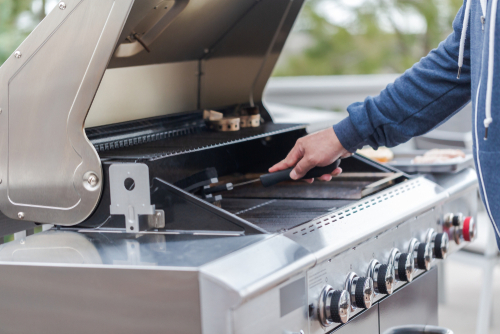A Guide To Propane Grill Tanks
Written on: March 18, 2024
Tips for grill tank maintenance, refills, and exchanges
 Spring is in the air—and with that comes the return to outdoor living and firing up the grill. While some people swear by charcoal, for the ease that makes grilling an any-night option you want to go with a propane-fired grill. Whether you have a full-featured outdoor kitchen or you’re just looking to grill some burgers or chicken on your deck, our team of pros can help you create the perfect propane grilling setup for your outdoor space.
Spring is in the air—and with that comes the return to outdoor living and firing up the grill. While some people swear by charcoal, for the ease that makes grilling an any-night option you want to go with a propane-fired grill. Whether you have a full-featured outdoor kitchen or you’re just looking to grill some burgers or chicken on your deck, our team of pros can help you create the perfect propane grilling setup for your outdoor space.
Propane grills are as easy to light as your kitchen range and offer you the ultimate in control. No messing with lighter fluid or coals, and you can adjust temperature and flame with the twist of a knob. Cleanup is a cinch, too.
Knowing what size propane grill tank you need is the first step.
What size tank do I need?
The size of your propane grill tank depends on the size of your grill. For a deluxe built-in grill, you can connect directly to your main propane storage tank that fuels your kitchen range, water heater and any other propane appliances or equipment in your home.
For freestanding grills, the manufacturer’s instructions will tell you specifically what size grill tank is appropriate for your grill, but in general, the sizes range from 20 to around 60 pounds for a full-size grill, although some grills can take a larger tank.
Most portable grills take smaller tanks, from 1- to 40-pound cylinders. The smallest tanks are disposable, but you can get 5-pound tanks that are refillable.
How long will my grill tank last?
While most portable tanks don’t come with a gauge, a good rule of thumb is that a standard 20-pound portable propane tank should get you through about 25 grilling sessions.
You can also check the weight of your tank. Check the cylinder for markings that let you know the “tare weight” or TW, the weight of the tank when empty. To calculate how much propane is in the tank, place the cylinder on a scale (a basic bathroom scale will work) and subtract the tare weight from the amount shown on the scale. So, if your 20-pound cylinder weighs 27 pounds, and the tare weight is 17, you have 10 pounds of propane or about half a tank. Or, pick up a digital propane tank scale at your local hardware store. Most come with a digital app to let you know when it’s time for a fill-up.
Refill or Exchange?
Whether you choose to refill or exchange your grill tank is mostly a matter of preference. Most people appreciate the swap-and-go convenience of cylinder exchange. But savvy customers love the ease and the savings they get by refilling.
When you own your propane tank and refill it, you can save on the price of the propane. The difference can be up to $1.75 per gallon!
Pico gives you both options at our multiple cylinder refill and exchange stations across Texas and New Mexico.
How to Replace a Tank
Removing and replacing your grill tank when you need a refill is easy.
First, make sure your grill is off, and the tank valve is closed (turn it all the way to the right, until it’s tight).
Next, unscrew the grill pressure regulator by turning it to the left. Some grill models also have a restraining bolt. Just loosen it and remove the tank.
To reconnect a full tank, simply follow those steps in reverse. Be sure the tank valve is closed when you reconnect the pressure regulator.
Ready to Grill?
Whether you need a cylinder refill or exchange, or you want to pick up an extra propane grill tank so you always have a spare, Pico is here to help you with our convenient tank refill and exchange service. We can help you upgrade your grilling game with a new grill, as well as propane-fueled fire pits, patio heaters and so much more. Contact us more information today.


 Spring is in the air—and with that comes the return to outdoor living and firing up the grill. While some people swear by charcoal, for the ease that makes grilling an any-night option you want to go with a propane-fired grill. Whether you have a full-featured outdoor kitchen or you’re just looking to grill some burgers or chicken on your deck, our team of pros can help you create the perfect propane grilling setup for your outdoor space.
Spring is in the air—and with that comes the return to outdoor living and firing up the grill. While some people swear by charcoal, for the ease that makes grilling an any-night option you want to go with a propane-fired grill. Whether you have a full-featured outdoor kitchen or you’re just looking to grill some burgers or chicken on your deck, our team of pros can help you create the perfect propane grilling setup for your outdoor space.